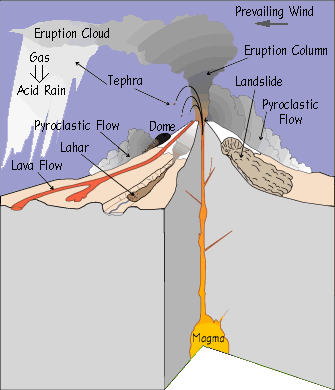© 2010 Naturesfury.net


Volcano Landslides and their Effects
Landslides are large masses of rock and soil that fall, slide, or flow very rapidly under the force of gravity. These mixtures of debris move in a wet or dry state, or both. Landslides commonly originate as massive rockslides or avalanches which disintegrate during movement into fragments ranging in size from small particles to enormous blocks hundreds of meters across. If the moving rock debris is large enough and contains a large content of water and fine material (typically, >3-5 percent of clay-sized particles), the landslide may transform into a lahar and flow downvalley more than 100 km from a volcano!
Volcano landslides range in size from less than 1 km3 to more than 100 km3. The high velocity (>100 km/hr) and great momentum of landslides allows them to run up slopes and to cross valley divides up to several hundred meters high. For example, the landslide at Mount St. Helens on May 18, 1980, had a volume of 2.5 km3, reached speeds of 50-80 m/s (180-288 km/hr), and surged up and over a 400 m tall ridge located about 5 km from the volcano!
Landslides are common on volcanoes because their massive cones typically rise hundreds to thousands of meters above the surrounding terrain; and are often weakened by the very process that created them--the rise and eruption of molten rock. Each time magma moves toward the surface, overlying rocks are shouldered aside as the molten rock makes room for itself, often creating internal shear zones or oversteepening one or more sides of the cone. Magma that remains within the cone releases volcanic gases that partially dissolve in groundwater, resulting in a hot acidic hydrothermal system that weakens rock by altering rock minerals to clay. Furthermore, the tremendous mass of thousands of layers lava and loose fragmented rock debris can lead to internal faults and fault zones that move frequently as the cone "settles" under the downward pull of gravity.
These conditions permit a number of factors to trigger a landslide or to allow part of a volcano's cone to simply collapse under the influence of gravity:
• intrusion of magma into a volcano
• explosive eruptions (magmatic or phreatic--steam-driven explosions)
• large earthquake directly beneath a volcano or nearby (typically >M5)
• intense rainfall that saturates a volcano or adjacent tephra-covered hillslopes with water, especially before or
during a large earthquake.
A landslide typically destroys everything in its path and may generate a variety of related activity. Historically, landslides have caused explosive eruptions, buried river valleys with tens of meters of rock debris, generated lahars, triggered waves and tsunami, and created deep horseshoe-shaped craters.
By removing a large part of a volcano's cone, a landslide may abruptly decrease pressure on the shallow magmatic and hydrothermal systems, which can generate explosions ranging from a small steam explosion to large steam- and magma-driven directed blasts. A large landslide often buries valleys with tens to hundreds of meters of rock debris, forming a chaotic landscape marked by dozens of small hills and closed depressions. If the deposit is thick enough, it may dam tributary streams to form lakes in the subsequent days to months; the lakes may eventually drain catastrophically and generate lahars and floods downstream.
Landslides also generate some of the largest and most deadly lahars, either by transforming directly into a lahar or, after it stops moving, from dewatering of the deposit. Historically, however, the most deadly volcano landslide occurred in 1792 when sliding debris from Mt. Mayuyama near Unzen Volcano in Japan slammed into the Ariaka Sea and generated a wave on the opposite side that killed nearly 15,000 people.
On a volcano, landslides typically carve deep gashes into its cone or create large horseshoe-shaped craters hundreds of meters deep and more than a kilometer in width.

